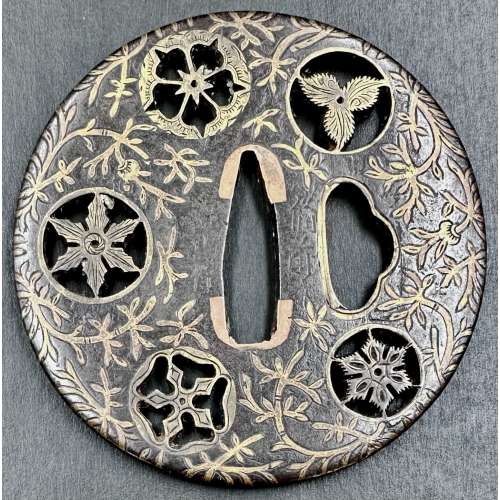Iron tsuba of almost round form decorated with five roundels – circular emblems of flowers and/or family crests (
mon) made of cast brass, pierced and chiselled in kebori, and with flat brass inlay (
hira-zōgan) of vines or seaweed all over the plate. Large hitsu-ana of ‘undulating cloud form’ outlined with brass. Nakago-ana of trapezoidal form, fitted with copper sekigane.
Signed on both sides of seppa-dai on both sides of the plate: Yoshirō of Bizen in Okayama made this (Bizen Okayama ju Yoshirō saku kore) [備前 岡山住 与四良 作之].
According to Torigoye’s book “Tsuba Geijitsu Kō”, written in around 1962: “It is clear that there were two generations who used the name Bizen Yoshirō. The first generation worked about Kambun era (1661-1672). The second generation worked about the Genroku era (1688-1703). […] In the work of the first Bizen Yoshirō we see large hitsu-ana of undulating cloud forms. This would seem the sole characteristic separating his work from the other Bizen artists. In rare cases small nanako dots, or gold and silver ten-zōgan are to be found. Sometime after the middle of the Edo age the work of the Bizen Yoshirō school disappears, and there is no later work in the style of this school. The signatures found on tsuba are the following: Yoshirō saku, or Yoshirō kore (wo) tsukuru, this is the signature of the first Bizen Yoshirō. Other signatures are Umon Nagatsugu, or Koike Umon Nagatsugu, with Okayama jū nin on the back. Also Bizen Yoshirō Nagatsugu saku. Umon Nagatsugu and Koike Nagatsugu are the same person”.
Bizen Province [備前国] is located in southeastern
Okayama Prefecture [岡山県].
Kanbun era [寛文] (April 1661 – September 1673).
Dimensions: 68.5 x 68.0 mm; Thickness at seppa-dai 3.4 mm
 NEWIron tsuba of almost round form decorated with five roundels – circular emblems of flowers and/or family crests (mon) made of cast brass, pierced and chiselled in kebori, and with flat brass inlay (hira-zōgan) of vines or seaweed all over the plate. Large hitsu-ana of ‘undulating cloud form’ outlined with brass. Nakago-ana of trapezoidal form, fitted with copper sekigane. Signed on both sides of seppa-dai on both sides of the plate: Yoshirō of Bizen in Okayama made this (Bizen Okayama ju Yoshirō saku kore) [備前 岡山住 与四良 作之].
NEWIron tsuba of almost round form decorated with five roundels – circular emblems of flowers and/or family crests (mon) made of cast brass, pierced and chiselled in kebori, and with flat brass inlay (hira-zōgan) of vines or seaweed all over the plate. Large hitsu-ana of ‘undulating cloud form’ outlined with brass. Nakago-ana of trapezoidal form, fitted with copper sekigane. Signed on both sides of seppa-dai on both sides of the plate: Yoshirō of Bizen in Okayama made this (Bizen Okayama ju Yoshirō saku kore) [備前 岡山住 与四良 作之].

